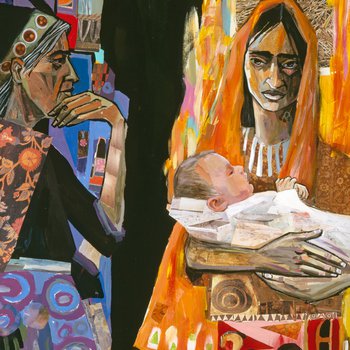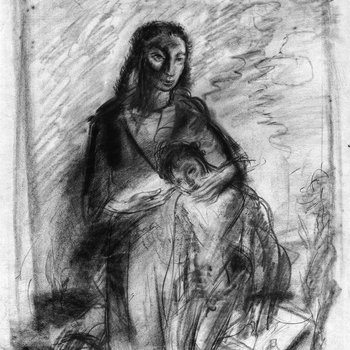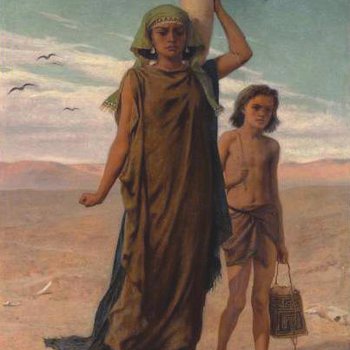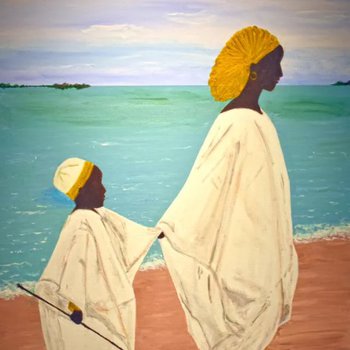Hagar
The “birth” of Islam (and Judaism) is actually a story about the interwining lives of two Ancient Mothers: Hagar and Sarai. Hagar, an Egyptian princess, whom her father (the Pharaoh) had “given” to Sarai (Ancient Mother of Judaism) was considered Sarai’s property, not the concubine or slave of Sarai’s husband, Abraham (Frymer-Kensky, 2002; Teubal, 1990). Some controversy exists as to exactly what status Hagar employed in relation to Sarai, whether it was that of Sarai’s shifhah, roughly translated this means “owned companion” or handmaid which was a higher social rank than slave, or if Hagar’s rank was actually that of a slave (Frymer-Kensky, 2002; Genesis 15:3-6; Teubal, 1990).
What can be determined is that Hagar, despite being a lower social rank than Sarai, played a vital role in the religious emergence accounts of Islam and Judaism (Young, 2013). She, like Abraham and Sarai, entered into a covenant with God who saved her and her son, Ishmael, in the wilderness after being forced to leave Sarai and Abraham. This is significant because Hagar is depicted as the one woman who had a direct relationship with God rather than an understanding of God via a male religious leader (Young, 2013).
In this narrative, and after being given to Sarai, Hagar traveled with Sarai and Abraham for about ten years before the question of children (or heirs) arose (Teubal, 1990). Hebrew Scripture states that Sarai, the the primary wife of Abraham, was unable to bear children herself so she proposed that Abraham have intercourse with her “owned companion,” Hagar, so that Hagar could bring forth a child for Sarai to claim as her own (Frymer-Kensky, 2002; Genesis 16:2; Teubal, 1990). Bloodlines were traced through the mother in the ancient Mesopotamian culture of Sarai and the ancient Egyptian culture of Hagar which meant that having children ensured the preservation of culture, the family unit, and the woman’s lineage (Frymer-Kensky, 2002; Teubal, 1990). Having a subordinate serve as a surrogate mother was a practice sometimes utilized in ancient civilizations and this process was controlled by the higher-ranking woman, not by her husband (Frymer-Kensky, 2002; Teubal, 1990). Thus, Hagar and Abraham fulfilled Sarai's request which quickly led to Hagar becoming pregnant. Tensions rose in this new situation, however, as Hagar felt more empowered when she was with child and regarded Sarai as more of an equal rather than as her superior (Frymer-Kensky, 2002; Genesis 15:3-6; Teubal, 1990). Because of her boldness, Hagar was subject to diminutive actions by Sarai whose goal was to reassert her authority over Hagar (Frymer-Kensky, 2002; Genesis 15:3-6; Teubal, 1990).
Hebrew Scripture goes on to say that, spurred by Sarai’s abusive actions, Hagar ran away but encountered God who insisted she return back to Sarai (Frymer-Kensky, 2002; Genesis 15:3-6; 16:7-14; Teubal, 1990). It is in this spiritual interaction that Hagar both names God - she is noted as the first historical agent to do so - and she enters into a covenant with God who promises that a great nation will arise from her child (Frymer-Kensky, 2002; Genesis 16:13; Teubal, 1990; Trible, 1984). Hagar does indeed return to Sarai and Abraham and gives birth to Ishmael. Years later, however, when Sarai births Issac and rejects Ishmael as an heir, Hagar and Ishmael are forced to leave (Frymer-Kensky, 2002; Genesis 21:8-13; Teubal 1984). Their departure ensures two things: that they are granted their freedom and that Ishmael is no longer eligible for an inheritance (Teubal, 1984).
Yet this is not the end of Hagar’s story, nor Sarai’s.* As Hagar and Ishmael struggled in the wilderness, Hebrew Scripture says that God protected them and provided for them, ensuring that Hagar became mother to the Muslim nation rendered by Ishmael’s descendants (Genesis 21:14-21). Muslims honor her status as mother to both Ishmael and to the Arab nation, a woman who was an exemplary follower of Allah because her faith saved both her and her son (Hāshimī, 2005; Ibn Hisham & Guillame, 1967). Hagar remains the first female to receive the divine promise of multiple descendants, a covenant typically reserved for patriarchs of Israel (Eskenazi & Weiss, 2008; Genesis 16:10; Trible, 1984).
Hagar further anchored Islam centuries later when Muhammad (The Prophet) traced his lineage back to Hagar, Abraham, and Ishmael in order to strengthen his religious advocacy for Islam (Ibn Hisham & Guillame, 1967; Qur’an 3:383-385; Stowasser, 1994). In this capacity, Hagar represents the first Muslim who completed the Hajj (or pilgrimage to Mecca), which became one of Islam’s Five Pillars of Faith (or religious tenets) (Hāshimī, 2005, 28). Additionally, the Ka’ba - or holiest shrine in Mecca, the Muslim holy city - marks the site upon which Hagar received divine intervention. Century after century devout Muslims have made yearly pilgrimages to this area in order to retrace her steps.
Hagar’s role as a matriarch and as the one who names God exemplifies her importance in the religious accounts of Islam and Judaism as well as models her “strength and courage [as one] of God’s chosen agents'' (Stowasser, 1994). Without Hagar, neither Islam nor Judaism would have been established.
(*See the “Ancient Mothers of Judaism” for more on Sarai’s story)
Works Cited
Eskenazi, T.C. & Weiss, A.L. (2008). Torah: A Women’s Commentary. New York, NY: URJ Press and Women of Reform Judaism.
Frymer-Kensky, T. (2002). Reading the Women of the Bible: A New Interpretation of their
Stories. New York, NY: Schocken Books.
Hāshimī, M.A. (2005). The Ideal Muslimah: The True Islamic Personality of the Muslim Woman as Defined in the Qur'an and Sunnah [Shakhṣīyat al-marʾah al-Muslimah] (al-Khattab, N. Trans.). Riyadh: International Islamic Publishing House.
Ibn Hisam, A. & Guillaume, A. (1967). The Life of Muhammad: A Translation [from Ibn Hisham's adaptation] of Ishaq's Sirat rasul Allah. London: Oxford University Press.
Stowasser, B.F. (1994). Women in the Qur’an, Traditions, and Interpretations. New York, NY:
Oxford University Press.
Teubal, S. J. (1984). Sarah the Priestess: The First Matriarch of Genesis. Athens, OH: Swallow
Press.
Teubal, S. J. (1990). The Lost Tradition of the Matriarchs: Hagar the Egyptian. New York, NY:
Harper & Row, Publishers, Inc.
Trible, P. (2003). Genesis 22: The sacrifice of Sarah. In J. M. Soskice, & D. Lipton (Eds.),
Feminism and Theology (pp. 144-154). New York, NY: Oxford University Press, Inc. Young, S. (Ed.). (1993). An Anthology of Sacred Texts by and about Women. New York, NY:
The Crossroad Publishing Company.




